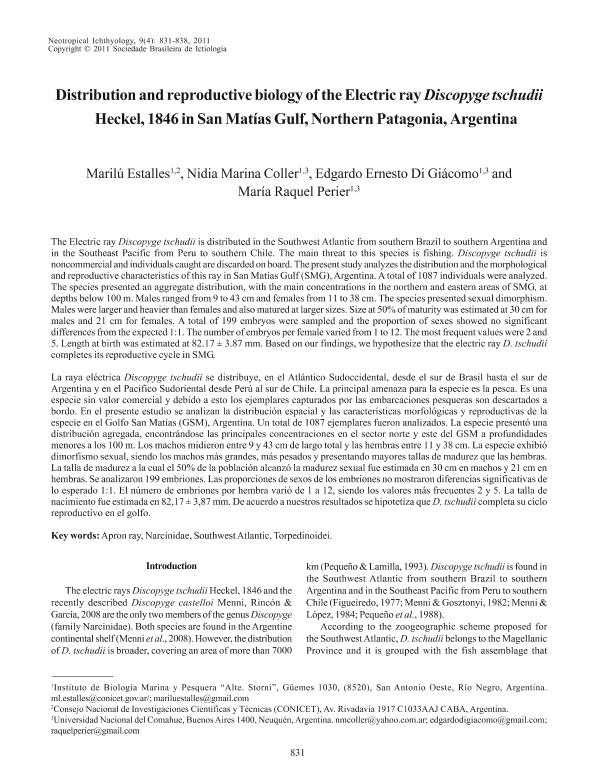Artículo
The Electric ray Discopyge tschudii is distributed form southern Brazil to Peru. The main threat to this species is fishing. Discopyge tschudii is noncommercial and individuals caught are discarded on board. The present study analyzes the distribution and the morphological and reproductive characteristics of this ray in San Matías Gulf (SMG). A total of 1087 individuals were analyzed. The species presented an aggregated distribution with the main concentrations in the northern and eastern areas of SMG at depths below 100 m. Males ranged from 9 to 43 cm and females from 11 to 38 cm. The species presented sexual dimorphism. Males were larger and heavier than females and they also matured at larger sizes. Size at 50% of maturity was estimated at 30 cm for males and 21 cm for females. A total of 199 embryos were sampled and the proportion of sexes showed no significant differences from the expected 1:1. The number of embryos per female varied from 1 to 12. The most frequent values were 2 and 5. Length at birth was estimated at 82.17 ± 3.87 mm. According to our findings we hypothesizes that the electric ray D. tschudii completes its reproductive cycle in SMG. La raya eléctrica Discopyge tschudii se distribuye, en el Atlántico Sudoccidental, desde el sur de Brasil hasta el sur de Argentina y en el Pacifico Sudoriental desde Perú al sur de Chile. La principal amenaza para la especie es la pesca. Es una especie sin valor comercial y debido a esto los ejemplares capturados por las embarcaciones pesqueras son descartados a bordo. En el presente estudio se analizan la distribución espacial y las características morfológicas y reproductivas de la especie en el Golfo San Matías (GSM), Argentina. Un total de 1087 ejemplares fueron analizados. La especie presentó una distribución agregada, encontrándose las principales concentraciones en el sector norte y este del GSM a profundidades menores a los 100 m. Los machos midieron entre 9 y 43 cm de largo total y las hembras entre 11 y 38 cm. La especie exhibió dimorfismo sexual, siendo los machos más grandes, más pesados y presentando mayores tallas de madurez que las hembras. La talla de madurez a la cual el 50% de la población alcanzó la madurez sexual fue estimada en 30 cm en machos y 21 cm en hembras. Se analizaron 199 embriones. Las proporciones de sexos de los embriones no mostraron diferencias significativas de lo esperado 1:1. El número de embriones por hembra varió de 1 a 12, siendo los valores más frecuentes 2 y 5. La talla de nacimiento fue estimada en 82,17 ± 3,87 mm. De acuerdo a nuestros resultados se hipotetiza que D. tschudii completa su ciclo reproductivo en el golfo.
Distribution and reproductive biology of the Electric ray Discopyge tschudii Heckel, 1846 in San Matías Gulf, Northern Patagonia, Argentina
Fecha de publicación:
10/2011
Editorial:
Sociedade Brasileira de Ictiologia
Revista:
Neotropical Ichthyology
ISSN:
1679-6225
e-ISSN:
1982-0224
Idioma:
Inglés
Tipo de recurso:
Artículo publicado
Clasificación temática:
Resumen
Palabras clave:
Apron Ray
,
Narcinidae
,
Southwest Atlantic
,
Torpedinoidei
Archivos asociados
Licencia
Identificadores
Colecciones
Articulos(CCT - PATAGONIA NORTE)
Articulos de CTRO.CIENTIFICO TECNOL.CONICET - PATAGONIA NORTE
Articulos de CTRO.CIENTIFICO TECNOL.CONICET - PATAGONIA NORTE
Citación
Estalles, María Lourdes; Coller, Nidia Marina; Di Giácomo, Edgardo Ernesto; Perier, María Raquel ; Distribution and reproductive biology of the Electric ray Discopyge tschudii Heckel, 1846 in San Matías Gulf, Northern Patagonia, Argentina; Sociedade Brasileira de Ictiologia; Neotropical Ichthyology; 9; 4; 10-2011; 831-838
Compartir
Altmétricas




